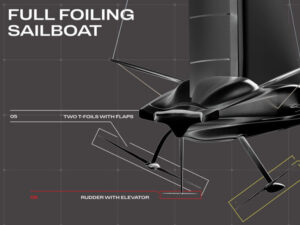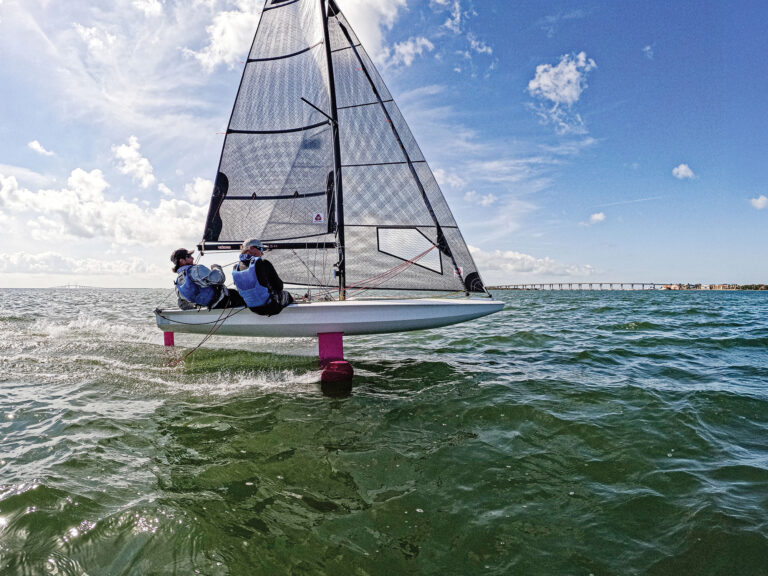
AC07_0712_Bajurin
Just days after the end of the most entertaining America’s Cup match in recent memory, the future of sailing’s biggest contest has been potentially thrown into limbo, or worse, the hands of the New York State Court of Appeals. The Golden Gate YC, which was the challenging club for Larry Ellison’s BMW Oracle Racing campaigns for the 31st and 32nd America’s Cup, has made an aggressive move to attempt to force Alinghi to reconsider the protocol for the 33rd America’s Cup, which it announced on July 5th, two days after successfully winning the 32nd America’s Cup match over Emirates Team New Zealand 5-2.The GGYC has submitted a challenge for the 33rd America’s Cup to the Societe Nautique de Geneve. The challenge maintains that the original challenge from Club Nautico Español de Vela (CNEV), which was accepted just moments after Alinghi defeated Emirates Team New Zealand, is invalid because the CNEV is “an entity organized in the form of a yacht club only a few days before the challenge was accepted by SNG and which has never had an annual regatta on an open water course on the sea or an arm of the sea as required by the Deed of Gift.”The letter to the SNG was sent by Marcus Young, Commodore of the GGYC, and Norbert Bajurin, Staff Commodore of the GGYC. However there is little doubt that this “rogue” challenge originates from Ellison’s Oracle Racing team. In fact, in the specifications for the challenge, the owner of the challenging yacht, named USA, is Oracle Racing, Inc.The protocol that was announced on July 5th was a significant departure from the format used for the 32nd Cup. Among the changes were the creation of a new 90-foot class-the rules for which would be drafted by Alinghi’s design group-a limitation of one new boat for each team, and the possibility that the defender could sail in all but the final round of the Louis Vuitton Cup. A date and location for the regatta were not part of the protocol, another bone of contention, according to the challenge issued by the GGYC.It was, on the surface, an agreement that seemed to give the defender a strong advantage, especially since Alinghi would be able to start work on their design long before the rule for the new class was officially announced. For most people familiar with the Cup this was taken with something akin to a shrug. “Who ever said anything about the America’s Cup being fair?”Obviously, Ellison and the GGYC decided to do something about it. The challenge outlined by the GGYC, which is available here, requests a best-of-3 series be sailed next summer, starting July 4, 2008, in sloop-rigged boats 90-feet long and 90-feet wide, with a maximum “boards down” draft of 20 feet. While the challenge doesn’t specify what type of boat this will be, it doesn’t take much imagination to see it will be a multihull of some sort.The one twist to the challenge is that the GGYC allows for this challenge to be replaced by a “Protocol comparable in scope, and similar in terms, to that used for the 32nd America’s Cup.” For veteran Cup fans, this all smells vaguely familiar. After Dennis Conner won the Cup in Fremantle, Australia, in 1987, he dragged his feet deciding where, when, and in what class of boat to hold the next Cup. Sir Michael Fay, the New Zealand businessman behind New Zealand Challenge, which lost to Conner in the finals of the 1987 Louis Vuitton Cup, issued a rogue challenge for the Cup, to be contested in boats 90 feet on the waterline. The ensuing mismatch between Fay’s gigantic sloop and Conner’s 60-foot cat is a dark patch in the Cup’s history.There was a drawn-out legal battle in the court system of New York State, which resulted in Conner’s win standing and also set a precedent for future disagreements over the wording of the Deed of Gift. Since the Deed was originally drafted within the State of New York, presumably any future legal actions would take place there as well.Given that it’s not likely that neither Ellison nor Alinghi president Ernesto Bertarelli will back down, this future of the Cup could once again lie with the court. That could take quite a bit of time to sort out. The court of public opinion will be a little more hasty and it will be quite interesting to see who comes out on top there. Ellison has often been cast as the brash American. But there are many who feel Alinghi overstepped its bounds in drafting the protocol for the 33rd match and are eager to see a competition more in line with what just took place. The press release from the GGYC is below.”After Alinghi won the 32nd America’s Cup on July 3rd, SNG accepted a challenge from CNEV. It appears that CNEV is a brand new yacht club specifically created for this challenge and as such fails to meet the requirements for a challenging yacht club as defined by the Deed of Gift. The Deed of Gift, a document written in 1857, defines the rules for the America’s Cup to this day. The Deed of Gift requires that the Challenging yacht club conduct an annual regatta on an arm of the sea. CNEV has never conducted a regatta of any kind and thus cannot be a legitimate Cup challenger. “Furthermore, the race Protocol for the 33rd America’s Cup agreed to by the challenging yacht club CNEV and the defending SNG are invalid because they fail to specify the rules for the next competition by omitting a specific regatta date, location and class of boat. The Protocol is also invalid because virtually all Challenger rights are eliminated and total control of the event and its rules are granted to the Defender, Team Alinghi. The Alinghi Protocol for the 33rd Americas Cup alters the very nature of the competition giving unprecedented and unfair advantages to the Defender. “Without the basic elements of regatta venue, date and boat design rules as required by the Deed of Gift, the Alinghi Protocol provides no opportunity for a fair and equitable competition. Only the Defender can begin to plan their campaign and design their yachts while all the other competitors must sit and wait for further information. We have spoken with most of our fellow AC 32 Challengers and we believe that they share our view. We seek to continue to expand and build upon the successes of the 32nd America’s Cup which was exciting and rewarding for competitors, sponsors, media and fans by returning to an environment where mutual consent in forming the rules provided a fair and close competition for all. “We will endeavor to work with SNG to mutually agree to appropriate terms for the 33rd America’s Cup to keep the event exciting and fair for all. Under SNG’s stewardship, the 32nd America’s Cup delivered some of the most hotly-contested racing in recent Cup history and brought Cup sailing to more people worldwide than ever before. We hope we can build on this for the future and continue the momentum we started here together in Valencia. “The Deed of Gift requires the Defender to accept a valid challenge, and together the Defender and Challenger can mutually agree on the rules for the competition. Failing such agreement, then the original rules in the Deed will dictate the terms, defaulting to a challenge to take place in ten months with a boat defined by the challenger.”









